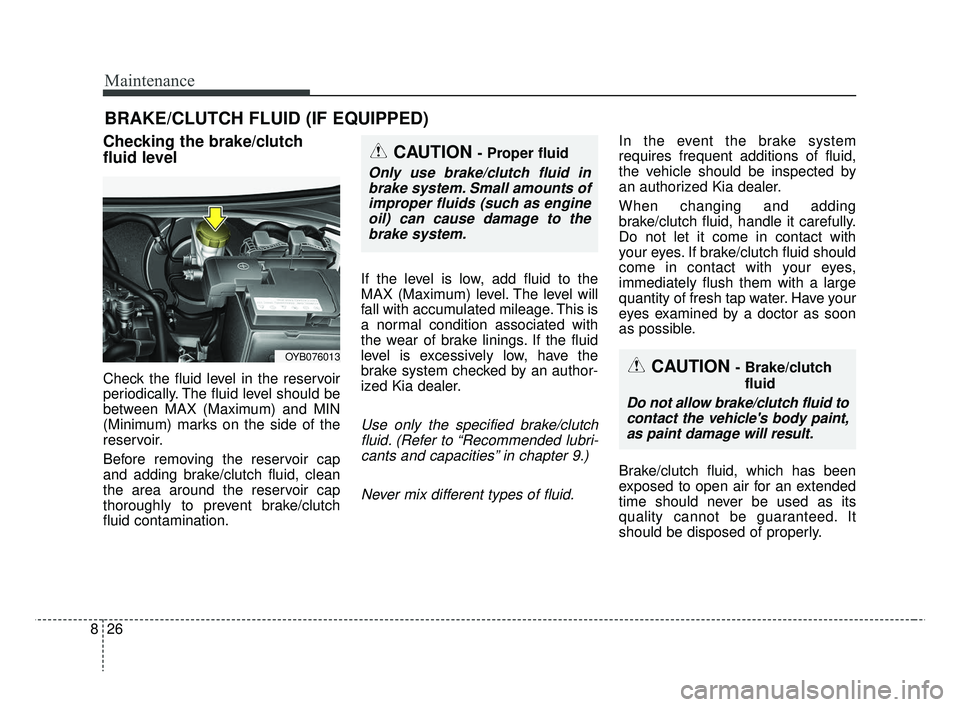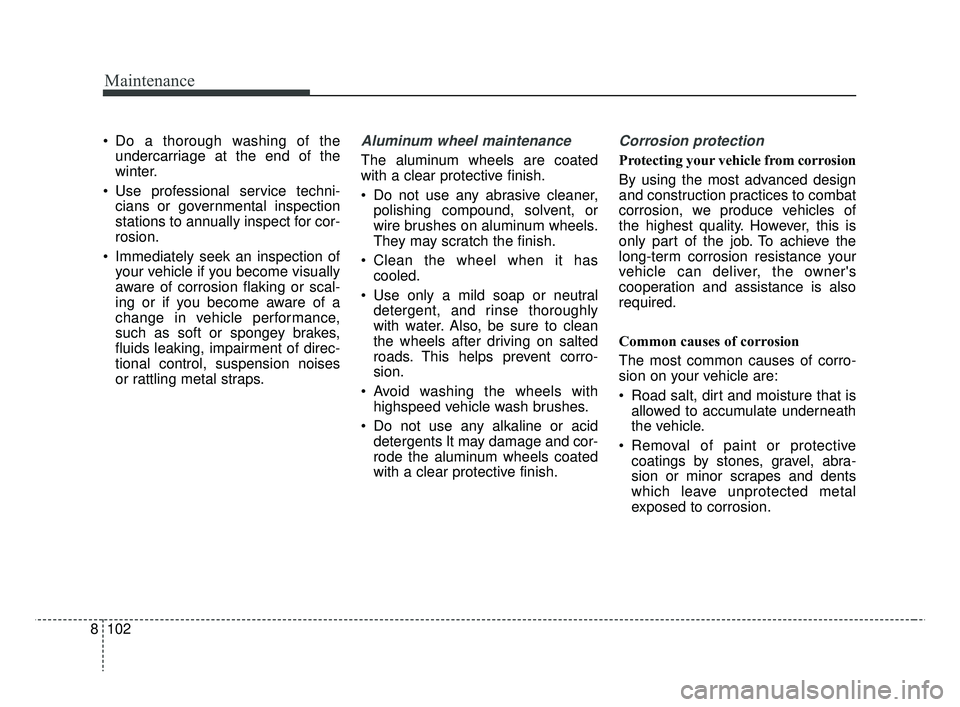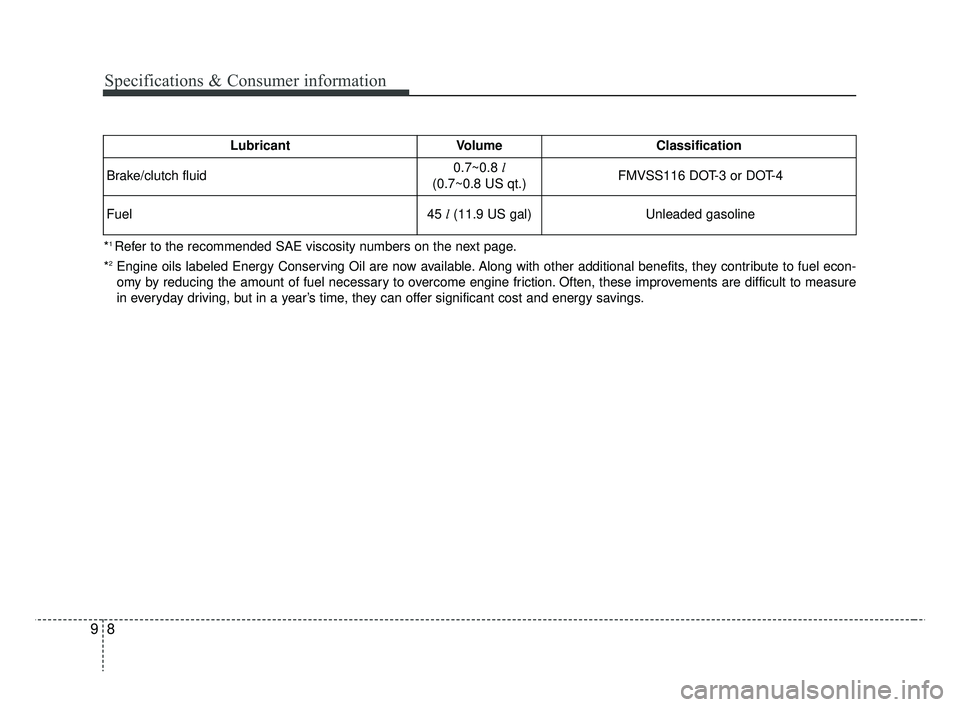2019 KIA RIO brake fluid
[x] Cancel search: brake fluidPage 398 of 503

Maintenance
26
8
BRAKE/CLUTCH FLUID (IF EQUIPPED)
Checking the brake/clutch
fluid level
Check the fluid level in the reservoir
periodically. The fluid level should be
between MAX (Maximum) and MIN
(Minimum) marks on the side of the
reservoir.
Before removing the reservoir cap
and adding brake/clutch fluid, clean
the area around the reservoir cap
thoroughly to prevent brake/clutch
fluid contamination. If the level is low, add fluid to the
MAX (Maximum) level. The level will
fall with accumulated mileage. This is
a normal condition associated with
the wear of brake linings. If the fluid
level is excessively low, have the
brake system checked by an author-
ized Kia dealer.
Use only the specified brake/clutch
fluid. (Refer to “Recommended lubri-cants and capacities” in chapter 9.)
Never mix different types of fluid.
In the event the brake system
requires frequent additions of fluid,
the vehicle should be inspected by
an authorized Kia dealer.
When changing and adding
brake/clutch fluid, handle it carefully.
Do not let it come in contact with
your eyes. If brake/clutch fluid should
come in contact with your eyes,
immediately flush them with a large
quantity of fresh tap water. Have your
eyes examined by a doctor as soon
as possible.
Brake/clutch fluid, which has been
exposed to open air for an extended
time should never be used as its
quality cannot be guaranteed. It
should be disposed of properly.
OYB076013CAUTION - Brake/clutch fluid
Do not allow brake/clutch fluid tocontact the vehicle's body paint,as paint damage will result.
CAUTION - Proper fluid
Only use brake/clutch fluid inbrake system. Small amounts ofimproper fluids (such as engineoil) can cause damage to thebrake system.
SC CAN (ENG) 8.qxp 7/18/2018 5:33 PM Page 26
Page 474 of 503

Maintenance
102
8
Do a thorough washing of the
undercarriage at the end of the
winter.
Use professional service techni- cians or governmental inspection
stations to annually inspect for cor-
rosion.
Immediately seek an inspection of your vehicle if you become visually
aware of corrosion flaking or scal-
ing or if you become aware of a
change in vehicle performance,
such as soft or spongey brakes,
fluids leaking, impairment of direc-
tional control, suspension noises
or rattling metal straps.Aluminum wheel maintenance
The aluminum wheels are coated
with a clear protective finish.
Do not use any abrasive cleaner,polishing compound, solvent, or
wire brushes on aluminum wheels.
They may scratch the finish.
Clean the wheel when it has cooled.
Use only a mild soap or neutral detergent, and rinse thoroughly
with water. Also, be sure to clean
the wheels after driving on salted
roads. This helps prevent corro-
sion.
Avoid washing the wheels with highspeed vehicle wash brushes.
Do not use any alkaline or acid detergents It may damage and cor-
rode the aluminum wheels coated
with a clear protective finish.
Corrosion protection
Protecting your vehicle from corrosion
By using the most advanced design
and construction practices to combat
corrosion, we produce vehicles of
the highest quality. However, this is
only part of the job. To achieve the
long-term corrosion resistance your
vehicle can deliver, the owner's
cooperation and assistance is also
required.
Common causes of corrosion
The most common causes of corro-
sion on your vehicle are:
Road salt, dirt and moisture that isallowed to accumulate underneath
the vehicle.
Removal of paint or protective coatings by stones, gravel, abra-
sion or minor scrapes and dents
which leave unprotected metal
exposed to corrosion.
SC CAN (ENG) 8.qxp 7/18/2018 5:37 PM Page 102
Page 490 of 503

Specifications & Consumer information
89
*1 Refer to the recommended SAE viscosity numbers on the next page.
*
2Engine oils labeled Energy Conserving Oil are now available. Along with other additional benefits, they contribute to fuel econ-
omy by reducing the amount of fuel necessary to overcome engine friction. Often, these improvements are difficult to measure
in everyday driving, but in a year’s time, they can offer significant cost and energy savings.
LubricantVolumeClassification
Brake/clutch fluid0.7~0.8 l
(0.7~0.8 US qt.)FMVSS116 DOT-3 or DOT-4
Fuel45 l(11.9 US gal)Unleaded gasoline
SC CAN (ENG) 9.qxp 8/3/2018 5:47 PM Page 8
Page 496 of 503

I3
Index
Power brakes ..............................................................6-24
Vehicle Stability Management (VSM)........................6-35
Brake/clutch fluid ..........................................................8-26 Checking the brake/clutch fluid level ........................8-26
Bulb wattage ....................................................................9-3
Checking fluid levels ....................................................8-20
Child Restraint System (CRS) ......................................3-26 Using a child restraint system ....................................3-27
Climate control air filter ................................................8-31 Filter inspection ..........................................................8-31
Cruise Control System ..................................................6-50 Cruise Control Switch ................................................6-50
To cancel cruise control ..............................................6-53
To decrease the cruising speed ..................................6-52
To increase cruise control set speed ..........................6-52
To resume cruising speed at more than approximately 30 km/h (20 mph) ....................................................6-53
To set cruise control speed..........................................6-51
To temporarily accelerate with the cruise control on 6-52
To turn cruise control off ............................................6-54
Declaration of conformity ............................................5-42 IC ........................................................................\
........5-42 Defroster ......................................................................4-\
108
Rear window defroster ..............................................4-108
Dimensions ......................................................................9-\
2
Door locks......................................................................4-\
19 Auto door lock/unlock feature ....................................4-22
Child-protector rear door lock ....................................4-22
Impact sensing door unlock system ............................4-22
Operating door locks from inside the vehicle ............4-20
Operating door locks from outside the vehicle ..........4-19
Speed sensing door lock system ................................4-22
Economical operation ....................................................6-56
Emergency starting ..........................................................7-5 Jump starting ..............................................................7-5
Emission control system ..............................................8-107 Crankcase emission control system ..........................8-107
Evaporative emission control (including ORVR: Onboard Refueling Vapor Recovery) system ........8-107
Exhaust emission control system ..............................8-108
Engine .................................................................\
...........9-2
Engine compartment ................................................2-7, 8-4
Engine coolant ..............................................................8-23 Changing the coolant ..................................................8-25
Checking the coolant level..........................................8-23\
Engine number ..............................................................9-11
C
D
E
SC CAN (ENG) Index.qxp 7/18/2018 5:31 PM Page 3
Page 503 of 503

Index
10I
Warning and indicator lights..........................................4-79Indicator lights ............................................................4-87
Warning lights ............................................................4-79
Washer fluid ..................................................................8-27 Checking the washer fluid level ................................8-27
Weight/volume ................................................................9-6
Windows ........................................................................\
4-33 Manual windows ........................................................4-38
Power windows ..........................................................4-34
Windshield defrosting and defogging..........................4-128 Automatic climate control system ............................4-129
Defogging logic ........................................................4-130
Manual climate control system ................................4-128
Winter driving ................................................................6-63 Carry emergency equipment ......................................6-65
Change to "winter weight" oil if necessary ................6-64
Check battery and cables ............................................6-64
Check spark plugs and ignition system ......................6-64
Don't let ice and snow accumulate underneath ..........6-65
Don't let your parking brake freeze ............................6-65
Snowy or icy conditions ............................................6-63
To keep locks from freezing ......................................6-64
Use approved window washer anti-freeze in system 6-64
Use high quality ethylene glycol coolant ..................6-64 Wiper blades ..................................................................8-33
Blade inspection ..........................................................8-33
Blade replacement ......................................................8-33
Wipers and washers ......................................................4-98 Rear window wiper and washer switch (for 5 door) ..4-102
Windshield washers (front) ......................................4-100
Windshield wipers ......................................................4-99
W
SC CAN (ENG) Index.qxp 7/18/2018 5:31 PM Page 10